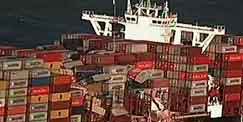In mid-February, an estimated 750 ocean containers full of inventory fell off a cargo ship while sailing through turbulent seas from China to Los Angeles, in the latest in what has been a number of incidents in which containers carrying goods worth millions have gone overboard.
The containers were lost about halfway through the Essen's voyage to LA. No crewman were injured in the incident, and the ship continued on to LA after.
Supply Chain Digest Says... |
 |
|
Maritime officials say ship operators are looking at installing sensors that could issue warnings on sea conditions to avoid parametric rolling.. |
|
 |
|
What do you say? |
|
| Click here to send us your comments |
|
| |
|
| Click here to see reader feedback |
|
|
|
Back in November, a ship operated by Singapore-based Ocean Network Express lost as many as 2,000 containers after encountering a storm near Hawaii on its way to Long Beach, CA from China, with the lost goods having an estimated value of $220 million.
The World Shipping Council says on average only 1,382 containers were lost at sea per year between 2018 and 2019. But between Nov. 30 and Jan. 31, more than 2,675 containers were lost in five incidents at sea. That's almost double the annual average in just a two-month period.
And that was before the 750 containers from the Maersk Essen went into the drink in February.
Historically, failures in lashing systems that hold containers together caused the accidents. But as container ships grow in size, boxes stacked extremely high come under great pressure from pitching and rolling on the seven seas - and sometimes wind up in the drink.
It appears a variety of factors he converge to create the catastrophic event termed "parametric rolling." How that happens was recently nice explained by the Wall Street Journal, with accompanying illustrations.
The fundamental issue: big waves hitting container ships at angle, so that instead of bobbing up and down from waves head on, the ships start to roll from side to side. It works like this, according to the Journal:
When a ship meets large waves, it begins to pitch and roll, the severity determined by the angle at which the waves hit the bow.
This happens as the sharp bow, which resembles an arrow tip, cuts through the water and pitches up and down.
As the wave crest travels along the streamlined hull, the flat stern enhances the rolling motion, but the momentum of the ship's forward movement allows the vessel to spread the energy from the crashing waves along the hull and keep it upright.
In very rough seas, the roll angle may increase from a few degrees to over 30 degrees after only a few instances of cresting waves.
(See More Below
|
CATEGORY SPONSOR: SOFTEON |
|
|
|
|
|
 Under these conditions, the rolling increases, and pressure from the motion can exceed the breaking limits of the lashings that hold the containers in place, causing them to snap. Under these conditions, the rolling increases, and pressure from the motion can exceed the breaking limits of the lashings that hold the containers in place, causing them to snap.
The containers, which can weigh several tons each, break away from their stacks, throwing off the balance of weight across the ship. This can intensify the pitching and rolling effect, throwing containers overboard.
To stop the pitching and rolling, the only thing a ship can do is slow down and change course.
All this of course is exacerbated by the growing size of the ships, with containers now stacked on decks much higher than on previous vessels.
Maritime officials say ship operators are looking at installing sensors that could issue warnings on sea conditions to avoid parametric rolling.
What are your thoughts containrs going in the drink? Let us know your thoughts at the Feedback section below
Your Comments/Feedback
|

